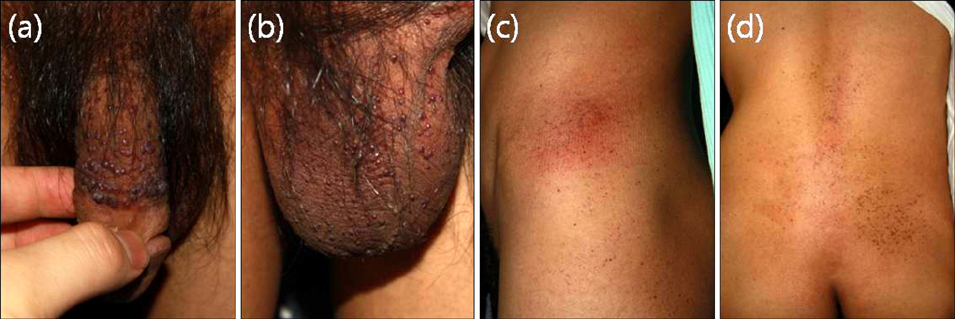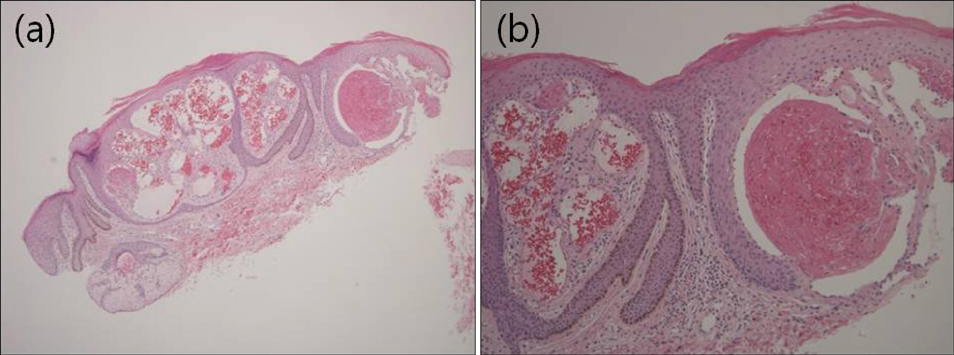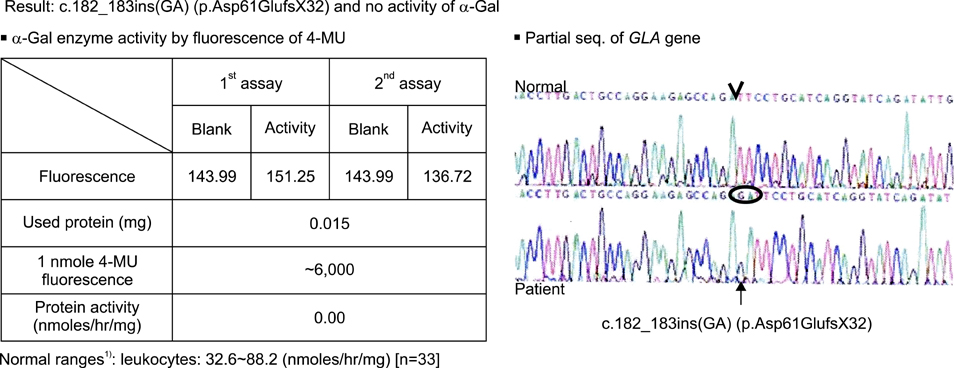Ann Dermatol.
2013 Feb;25(1):95-98. 10.5021/ad.2013.25.1.95.
A Novel Frameshift Mutation of Galactosidase-alpha in Fabry Disease Restricted to Dermatologic Manifestations
- Affiliations
-
- 1Department of Dermatology, School of Medicine, Chungnam National University, Daejeon, Korea. jhoon@cnu.ac.kr
- KMID: 2265979
- DOI: http://doi.org/10.5021/ad.2013.25.1.95
Abstract
- A 28-year-old Asian male was referred for dermatologic evaluation of diffuse bluish-red maculopapules in the lower trunk and genital regions. There was no family history, and with the exception of dispersed skin lesions and hypohidrosis, no other complaints or symptoms were present. Histological evaluation of the skin lesions revealed angiokeratomas. When this combination of clinical and histological findings is observed, Fabry disease is suspected. Biochemical examination performed for definitive diagnosis did not show any activity of the alpha-galactosidase A enzyme. Through identification of a c.182_183ins(GA) mutation of the GLA gene, Fabry disease was diagnosed. However, there was no particular abnormal finding with regard to the evaluation of non-cutaneous manifestations, a symptom that can occur in the progress of this disease. We reported a case of Fabry disease, restricted to the dermatologic presentation, involving a novel frameshift mutation in the GLA gene.
Keyword
MeSH Terms
Figure
Reference
-
1. Sweeley CC, Klionsky B. Fabry's disease: classification as a sphingolipidosis and partial characterization of a novel glycolipid. J Biol Chem. 1963. 238:3148–3150.
Article2. Schiffmann R. Fabry disease. Pharmacol Ther. 2009. 122:65–77.
Article3. Lee BH, Heo SH, Kim GH, Park JY, Kim WS, Kang DH, et al. Mutations of the GLA gene in Korean patients with Fabry disease and frequency of the E66Q allele as a functional variant in Korean newborns. J Hum Genet. 2010. 55:512–517.
Article4. Lee JK, Kim GH, Kim JS, Kim KK, Lee MC, Yoo HW. Identification of four novel mutations in five unrelated Korean families with Fabry disease. Clin Genet. 2000. 58:228–233.
Article5. Altarescu GM, Goldfarb LG, Park KY, Kaneski C, Jeffries N, Litvak S, et al. Identification of fifteen novel mutations and genotype-phenotype relationship in Fabry disease. Clin Genet. 2001. 60:46–51.
Article6. Sugawara K, Ohno K, Saito S, Sakuraba H. Structural characterization of mutant alpha-galactosidases causing Fabry disease. J Hum Genet. 2008. 53:812–824.
Article7. MacDermot KD, Holmes A, Miners AH. Anderson-Fabry disease: clinical manifestations and impact of disease in a cohort of 98 hemizygous males. J Med Genet. 2001. 38:750–760.
Article8. von Scheidt W, Eng CM, Fitzmaurice TF, Erdmann E, Hübner G, Olsen EG, et al. An atypical variant of Fabry's disease with manifestations confined to the myocardium. N Engl J Med. 1991. 324:395–399.
Article9. Nakao S, Kodama C, Takenaka T, Tanaka A, Yasumoto Y, Yoshida A, et al. Fabry disease: detection of undiagnosed hemodialysis patients and identification of a "renal variant" phenotype. Kidney Int. 2003. 64:801–807.
Article10. Desnick RJ, Allen KY, Desnick SJ, Raman MK, Bernlohr RW, Krivit W. Fabry's disease: enzymatic diagnosis of hemizygotes and heterozygotes. Alpha-galactosidase activities in plasma, serum, urine, and leukocytes. J Lab Clin Med. 1973. 81:157–171.11. Wilcox WR, Oliveira JP, Hopkin RJ, Ortiz A, Banikazemi M, Feldt-Rasmussen U, et al. Fabry Registry. Females with Fabry disease frequently have major organ involvement: lessons from the Fabry Registry. Mol Genet Metab. 2008. 93:112–128.
Article
- Full Text Links
- Actions
-
Cited
- CITED
-
- Close
- Share
- Similar articles
-
- Fabry Disease in a Family: Four Patients and Five Carriers
- Two cases of Fabry disease identified in brothers
- Two Cases of Fabry Disease in Women with Proteinuria Diagnosed by Molecular Analysis of the alpha-Galactosidase A Gene and Kidney Biopsy
- Fabry disease previously diagnosed as Henoch-Schonlein purpura
- A Case of Fabry Disease Diagnosed by Molecular Analysis of alpha-galactosidase A Gene




